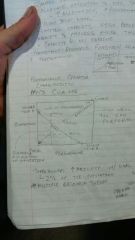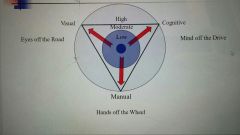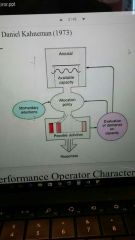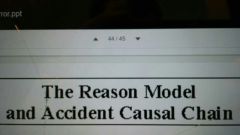![]()
![]()
![]()
Use LEFT and RIGHT arrow keys to navigate between flashcards;
Use UP and DOWN arrow keys to flip the card;
H to show hint;
A reads text to speech;
63 Cards in this Set
- Front
- Back
|
Selective Attention |
The ability to selectively process some sources of info. while ignoring others. -Select info. that is most importsnt to our current set of goals and exclude irrelevant sources of info. -Schizophrenia is an example where people are failing to suppress the processing of irrelevant stimuli/thoughts. |
|
|
Facilitatory Processes |
Amplify the processing of task-relevant info. |
|
|
Inhibitory Processes |
Dampen the processing of irrelevant info. |
|
|
Divided Attention |
The ability to perform two or more concurrent tasks or activities. |
|
|
Sustained Attention |
The ability to maintain the focus of attention for prolonged periods. |
|
|
Broadbent's Filter Theory |
Applied the concept of limited capacity channel to attention, proposing that attention acts as a filter allowing only relevant info. To pass to higher levels and exlcuding irrelevant info. from info.-processing system. |
|
|
Early Selection Theories |
Irrelevant info. filtered upfront and not sent to processing system. |
|
|
Late Selection Model |
All info. is processed for meaning and selection occurs at the level of response. (Deutsch and Deutsch) |
|
|
Inattentional Blindness |
Mechanisms of selective attention are effective in filtering out highly salient, but irrelevant, information. (Gorilla in basketball vid.) |
|
|
Stroop-like Interference |
Inability to filter out irrelevant info. |
|
|
Vigilance Tasks |
Situations in which an observer must sustain attention for prolonged periods of time. (Watching x-ray for prohibited items in airport.) |
|
|
Dichotic Listening Studies |
Two messages played at same time. Subjects only able to process and report on one stream of received info. Unaware of German and backwards messages in filtered stream. |
|
|
Triesman's Attenuation Theory |
-Filtered channels are 'turned down' (attenuated) instead of lost/filtered completely out. -Pertinent info. from unattended channels processed. |
|
|
Visual Search Task |
Three Conditions: -Shape -Color -Shape & Color (Conjunction of features) *Most Difficult* Search is also more effective when searching for presence of an object rather than absence. |
|
|
Feature Integration Theory |
-Attention binds features together. -Attention is gluing together different features of objects. |
|
|
Stroop Task |
-Standardized Test -Shows successes/failures of selective attention. Three Conditions: -Neutral-(Xs) Easy -Congruent-(Word=Color) Easiest -Incongruent-(Word Doesn't Equal Color) Hard |
|
|
Space-Based Effect |
Easier to differentiate things that are close together. |
|
|
Object-Based Effect |
Easier to compare things within one object than to compare two objects. -BUT it's easier to ignore irrelevant info. on different objects than on one object. |
|
|
Action-Based Effect |
Organized into objects to act upon. -Perception organizes world into objects that we can act upon (attend to). |
|
|
Attention Restoration Theory |
Natural environments work to restore attentional fatigue caused by different aspects of attention. |
|
|
Voluntary Attention |
-Effortful -Choosing what to focus on -Also called sustained, directed, or focused. -Technology exhausts -Top-Down Processing -Goal-Directed -Subject to depletion or mental fatigue. |
|
|
Involuntary Attention |
-Not subject to fatigue -Bottom-Up Processing -Less Goal-Directed -Intense stimuli causing hard fascination (sports game) -Needs to be sufficiently gentle, causing soft fascination (internal thinking) |
|
|
Components of Attention Restoration Theory |
1. Soft fascination: Internal reflection 2. Extent: Ability to explore, hold attention, use all senses. 3. Compatibility: Comfortable in setting 4. Being away: Removed from stressors |
|
|
Effective Dose of Nature |
3 days |
|
|
Performance Operator Characteristic (POC) Curves |

|
|
|
Supertaskers |
Performance stays constant or increases when attempting dual tasks. 2% of the population. |
|
|
Driver Distraction Triad |

|
|
|
Multiple Resource Theory |

Better able to perform dual tasks when different resources are used. Easier to perform a visual and auditory task congruently than to perform two visual tasks. |
|
|
Kahneman Flush Tank Model |

|
|
|
Performance-Resource Function |
Relationship between attention and performance. -More attention=Higher performance *Data-limited & Resource-limited |
|
|
Anatomy of an Interruption |
Immediate resumption: Ignore interruption, continue task Dual-Tasking: Switch attention back and for between tasks Abandonment: Attend to interruption and don't return to original task Delayed resumption: Resume initial task after attending to interruption Omission: Distracted by attending to interruption and skip step in when returning to initial task Partial repetition: Repeat last step when returning to initial task Toral repetition: Start initial task over when returning Delayed Interruption: Finish initial task and attend to interruption afterward |
|
|
Slips |
Actions captured by automatic routines (stuck in autopilot) |
|
|
Lapses |
Memory errors, forgetting |
|
|
Mode Errors |
Right action in the wrong context |
|

|

|
|
|
Limited Capacity |
We can not see, attend to, remember, or react to everything we encounter. (Attentional bottleneck) |
|
|
Flexibly Allocated |
We can control where we place our attentional resources. |
|
|
Cross-Talk |
Potential interference of "cross-talk" as brain strives to perform dual-tasks. |
|
|
Exogenous Cuing |
A peripheral cue automatically draws (orients) attention to a spatial location. -Fast and effortless |
|
|
Endogenous Cues |
A central cue directs attention to peripheral locations in a controlled, goal-oriented fashion. -Slow and effortful Three mechanisms -Disengage.. From current focus -Move.. Attention to new location -Engage.. Attention on new object |
|
|
Zoom Lens |
Low resolution attention can be distributed over larger area but with less ability to pick out fine details. Higher resolution distracted over small space with greater ability to see details. |
|
|
Object File |
Prototype of object... All attributes of object are processed in parallel. |
|
|
Psychological Refractory Period |
In order to start a second task one must wait until completion of the prior task. Only at that point will the required attention be able to fit through the "bottle neck" of attentional capacity. |
|
|
Cognitive Tunnel Vision |
Result of attention being too selective. -Stress, workload, and fatigue can increase likeliness. |
|
|
Expectancy |
We often see what we expect to see. |
|
|
Data-limited |
Allocating more attention to a task does not improve performance. (In Performance-resource function) |
|
|
Resource-limited |
Allocating more attention to a task improves performance. |
|
|
How much can attention be divided? |
4-6 Independent Activities, with performance dropping dramatically as # goes above 4. |
|
|
Mental Workload "Middle Ground" |
When task demands are high enough to keep the operator alert and functioning at high levels of performance, but not so high as to overtax the individual. |
|
|
Primary Task Performance |
As performance degrades, workload must have increased. |
|
|
Secondary Task Performance |
As performance on secondary task declones, mental workload of primary task increases. |
|
|
4 Methods of Measuring Workload |
1. Primary Task Measures 2. Secondary Task Measures 3. Physiological Measures 4. Subjective Measures (NASA-TLX) |
|
|
Adaptive Automation |
Computer takes over low priority tasks that the operator cannot perform under high workload and as that workload decreases the computer relinquishes control to operator. |
|
|
Successive Discrimination |
Compare item in question to an internal template in working memory. Puts heavy load on working memory. |
|
|
Simultaneous Discrimination |
External template provided for comparison in order to ease burden on working memory. |
|
|
Novice Performance |
Characterized as slow, effortful, and reliant on limited capacity attention. |
|
|
Expert Performance |
Characterized as fast, effortless, and automatic. |
|
|
Consistent Mapping |
Similarities across activities lead to performance improvement and eventual become automatic. |
|
|
Varied Mapping |
Mapping of stimulus to response varies across blocks trials, performance does not improve with practice and remains subject to the capacity limitations of attention. |
|
|
Perfect Time-sharing |
Automatically processed tasks can be combined in dual-task situations with little change in performance. |
|
|
Part-Task Training |
Task analysis is used to identify the consistent components of a task. Sub-tasks are practiced separately until proficient and brought back together. |
|
|
Variable Priority Training |
Perform whole task but systematically emphasize some component of the whole task while deemphasizing other parts. Effective. |
|
|
Phases of Skill Acquisition |
1. Declarative: general processing abilities 2. Knowledge compilation: perceptual speed ability 3. Procedural: psychomotor ability |

